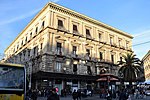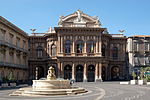San Cristoforo Minore, Catania
18th-century churches in ItalyBaroque architecture in CataniaBaroque church buildings in SicilyRoman Catholic churches in Catania
San Cristoforo Minore is a small former-Roman Catholic church or oratory located on the piazza Turi Ferro, formerly of Santo Spirito, near the center of the city of Catania, Sicily, southern Italy. It is putatively now the church of San Leone and owned by the Greek Orthodox parish of Catania, but is mostly closed. The church has a slender Baroque facade and sits on a forgotten, somewhat decrepit, urban island between streets. In the 18th century, the church as associated with a Catholic confraternity: the Congregazione Santissima Maria Addolorata.
Excerpt from the Wikipedia article San Cristoforo Minore, Catania (License: CC BY-SA 3.0, Authors).San Cristoforo Minore, Catania
Via Giacomo Puccini, Catania Centro storico
Geographical coordinates (GPS) Address Nearby Places Show on map
Geographical coordinates (GPS)
| Latitude | Longitude |
|---|---|
| N 37.506482137654 ° | E 15.088550067255 ° |
Address
Chiesa Greco-Ortodossa di San Leone
Via Giacomo Puccini
Catania, Centro storico
Sicily, Italy
Open on Google Maps









